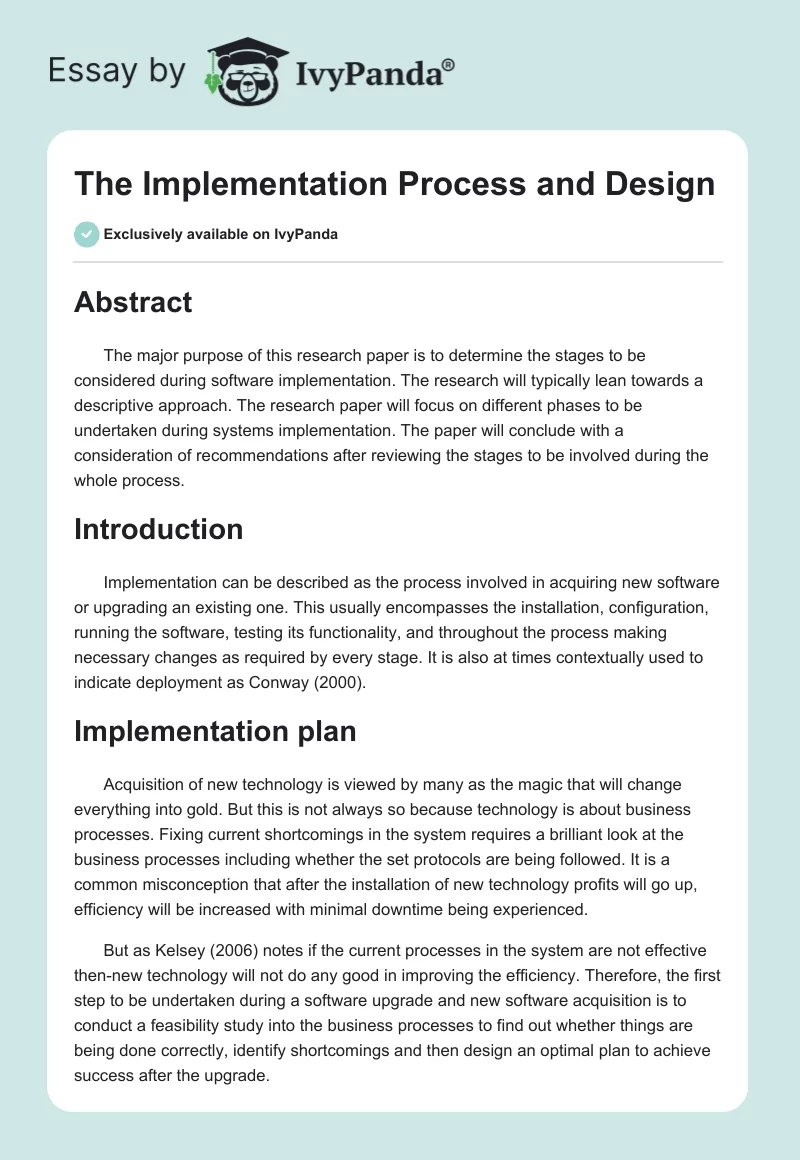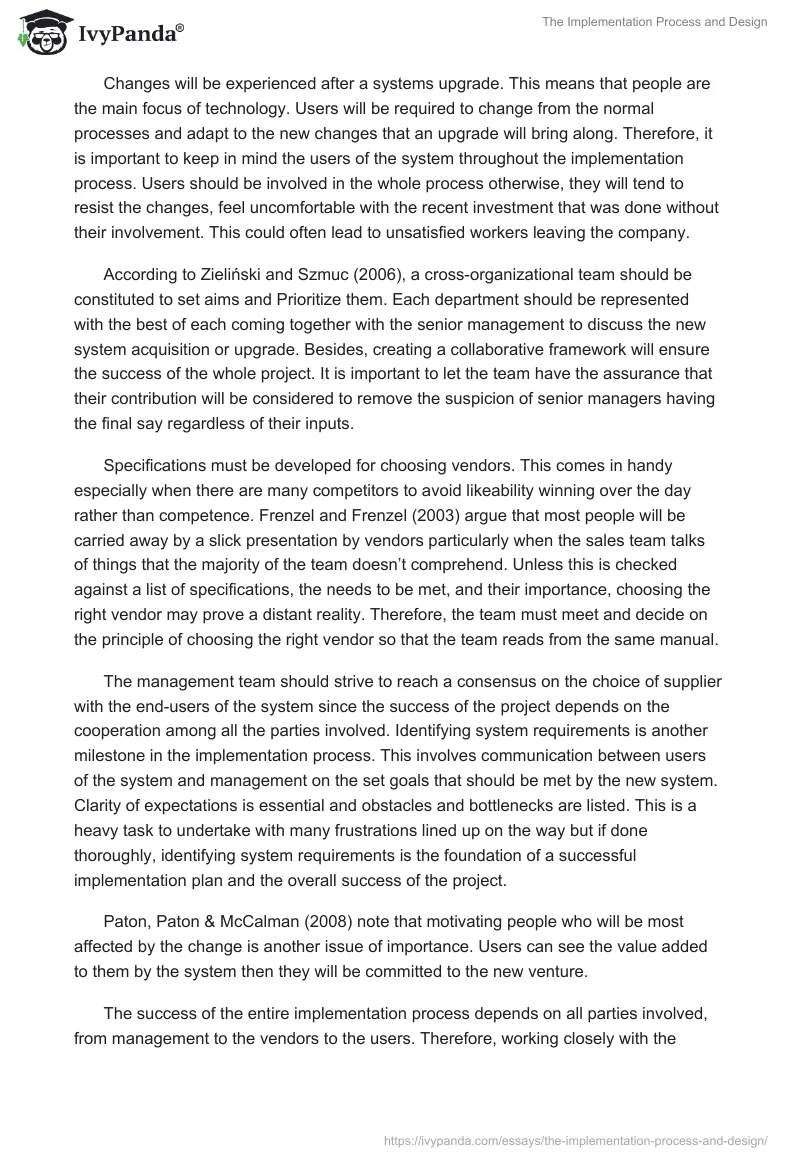Abstract
The major purpose of this research paper is to determine the stages to be considered during software implementation. The research will typically lean towards a descriptive approach. The research paper will focus on different phases to be undertaken during systems implementation. The paper will conclude with a consideration of recommendations after reviewing the stages to be involved during the whole process.
Introduction
Implementation can be described as the process involved in acquiring new software or upgrading an existing one. This usually encompasses the installation, configuration, running the software, testing its functionality, and throughout the process making necessary changes as required by every stage. It is also at times contextually used to indicate deployment as Conway (2000).
Implementation plan
Acquisition of new technology is viewed by many as the magic that will change everything into gold. But this is not always so because technology is about business processes. Fixing current shortcomings in the system requires a brilliant look at the business processes including whether the set protocols are being followed. It is a common misconception that after the installation of new technology profits will go up, efficiency will be increased with minimal downtime being experienced.
But as Kelsey (2006) notes if the current processes in the system are not effective then-new technology will not do any good in improving the efficiency. Therefore, the first step to be undertaken during a software upgrade and new software acquisition is to conduct a feasibility study into the business processes to find out whether things are being done correctly, identify shortcomings and then design an optimal plan to achieve success after the upgrade.
Changes will be experienced after a systems upgrade. This means that people are the main focus of technology. Users will be required to change from the normal processes and adapt to the new changes that an upgrade will bring along. Therefore, it is important to keep in mind the users of the system throughout the implementation process. Users should be involved in the whole process otherwise, they will tend to resist the changes, feel uncomfortable with the recent investment that was done without their involvement. This could often lead to unsatisfied workers leaving the company.
According to Zieliński and Szmuc (2006), a cross-organizational team should be constituted to set aims and Prioritize them. Each department should be represented with the best of each coming together with the senior management to discuss the new system acquisition or upgrade. Besides, creating a collaborative framework will ensure the success of the whole project. It is important to let the team have the assurance that their contribution will be considered to remove the suspicion of senior managers having the final say regardless of their inputs.
Specifications must be developed for choosing vendors. This comes in handy especially when there are many competitors to avoid likeability winning over the day rather than competence. Frenzel and Frenzel (2003) argue that most people will be carried away by a slick presentation by vendors particularly when the sales team talks of things that the majority of the team doesn’t comprehend. Unless this is checked against a list of specifications, the needs to be met, and their importance, choosing the right vendor may prove a distant reality. Therefore, the team must meet and decide on the principle of choosing the right vendor so that the team reads from the same manual.
The management team should strive to reach a consensus on the choice of supplier with the end-users of the system since the success of the project depends on the cooperation among all the parties involved. Identifying system requirements is another milestone in the implementation process. This involves communication between users of the system and management on the set goals that should be met by the new system. Clarity of expectations is essential and obstacles and bottlenecks are listed. This is a heavy task to undertake with many frustrations lined up on the way but if done thoroughly, identifying system requirements is the foundation of a successful implementation plan and the overall success of the project.
Paton, Paton & McCalman (2008) note that motivating people who will be most affected by the change is another issue of importance. Users can see the value added to them by the system then they will be committed to the new venture.
The success of the entire implementation process depends on all parties involved, from management to the vendors to the users. Therefore, working closely with the chosen vendors and implementation partners will yield success and the opposite is also true. This is a situation whereby everyone succeeds, or everyone fails.
Finally, a core process in the implementation process is change management. This according to Paton, Paton & McCalman (2008) is a process that occurs continuously over the whole period from procurement to implementation. The management must prepare the users for the planned changes and seek their input. It is a common error for the management to assume that everyone will find the new system exciting. Given that people don’t like change, the initial step in change management should be to inform the end-users of the intended changes, and from that, they will be more responsive to change since it is something they expect.
Conclusion
The implementation process and design are essential parts used to determine the success or failure of new technology, therefore, more time should be spent here to verify every activity of every phase is clearly defined and understood by all players involved.
References List
Conway, K. (2000). Software Project Management: From Concept to Deployment. Arizona, AZ: Coriolis Group.
Frenzel, C. W., & Frenzel, J. (2003). Management of Information Technology. Virginia, VA: Thomson Course Technology.
Kelsey, R. B. (2006). SoftwareProject Management: Measures for Improving Performance. Virginia, VA: Management Concepts.
Paton, R. A., Paton R., McCalman, J. (2008). Change Management: A Guide to Effective Implementation. California, CA: SAGE Publications Ltd.
Zieliński, K., Szmuc T. (2006). Software Engineering: Evolution and Emerging Technologies. Virginia, VA: IOS Press.


